After winning the Premier League for the first time, Liverpool have maintained the core of their squad and added a few interesting names in the summer. The current financial situation means big transfers are unlikely to happen and Liverpool have an army of loan players they could call back next season if needed.
In this data analysis, we will look at the players Liverpool have loaned out this season and their performances so far, looking to predict whether they could have an impact at their parent club in the future or not. Players are ordered by their value and all percentiles shown in the graphs are compared to the players in the same position and in the same league the player is playing in. When we say a player is top 5% it means he’s better than the 95% of the players in the same league and position in the given metric.
Harry Wilson
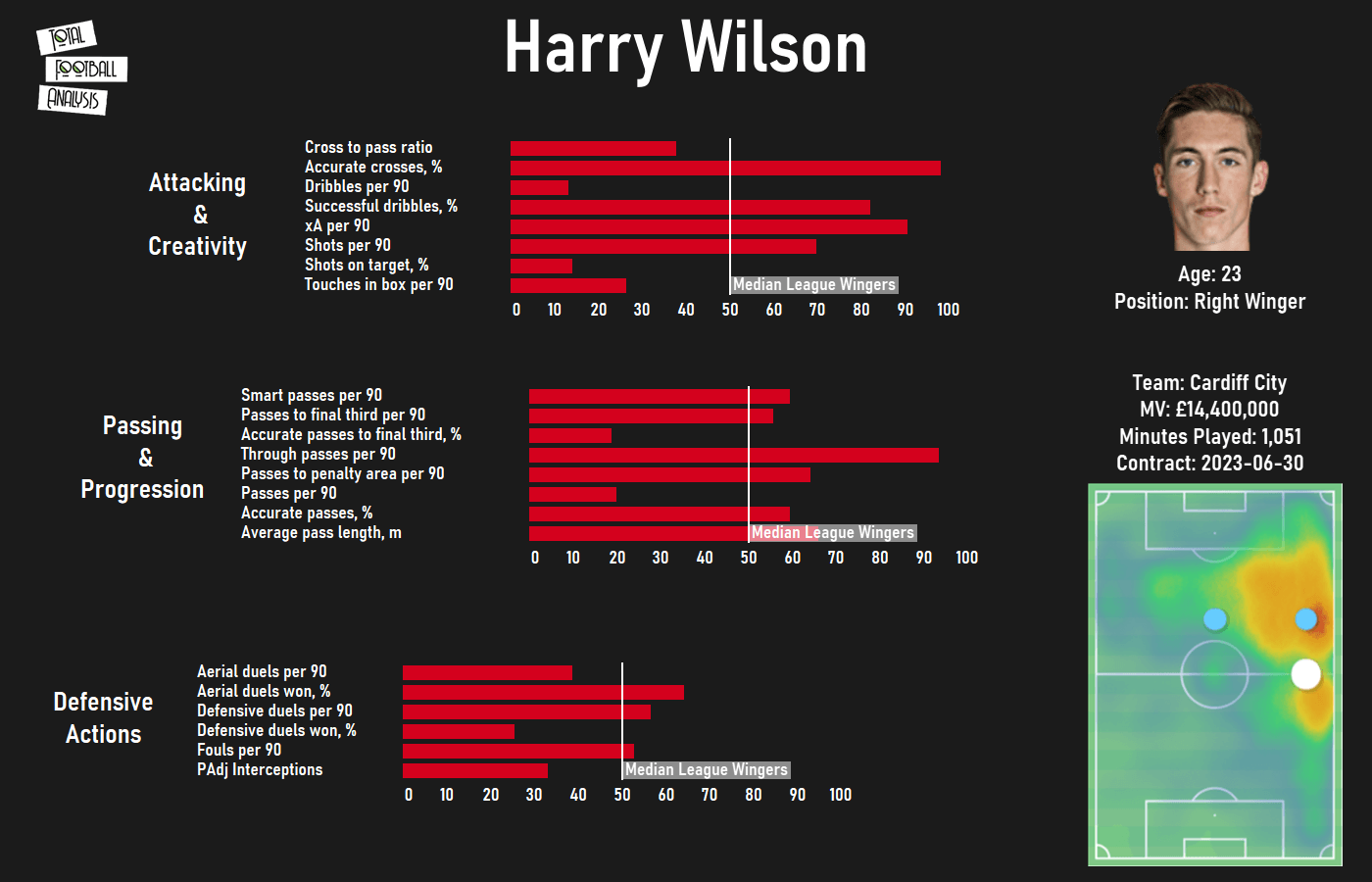
Harry Wilson is a household name for every EPL fan. The Welsh international enjoyed a very good 2019/20 season at Bournemouth despite the relegation and is knows as one of the finest left feet in the United Kingdom. A Liverpool player since he was eight, Wilson impressed for Liverpool U23 scoring 32 and assisting 14 in 60 matches before going on loan to Crewe Alexandra in the League One (seven matches), Hull City and Derby County (both in the Championship with a total of 53 matches, 22 goals and seven assists). This season he has gone back to the Championship with Cardiff City and he has played 13 league matches so far scoring three goals and assisting five times.
Wilson acts from the right-wing, looking to come inside to his left foot. His shooting ability is his best attribute and it’s not surprising that Wilson tries his luck very often, averaging 1.88 shots per 90 (top 30.2%). His excellent finishing explains why he’s in the top 35% for goals per 90 with 0.17 with just 0.1 xG per 90, which is in the bottom 36% of the league.
The rest of Wilson’s game gravitates around his shooting ability. He doesn’t often dribble to get past his opponent but to prepare his shot and that’s why his dribbling figures are low (2.74 dribbles per 90 – bottom 13.2) but his accuracy high as he just needs to win some space and not really dribble past the defender (62.5% successful dribbles – top 18%). His excellent delivery also translates into very accurate crosses (52.63% successful crosses – top 1.9%).
When it comes to creating for his teammates, he does have some ability to play through passes, especially after feinting shots, as his 1.46 through passes per 90 prove (top 6.7%). His success rate in this kind of passes is just ok. His high expected assists (0.24 per 90 – top 9.5%) come mostly because of his crossing ability from open play and specially set pieces. When it comes to his vision to break defences with his passing, Wilson is a slightly above average player.
On the defensive side, Wilson’s work rate is ok for the position and he gets involved in a decent number of duels. He’s not expected to win lots of them and he doesn’t, but he tries and is not afraid to foul the rival to stop dangerous attacks.
Marko Grujic
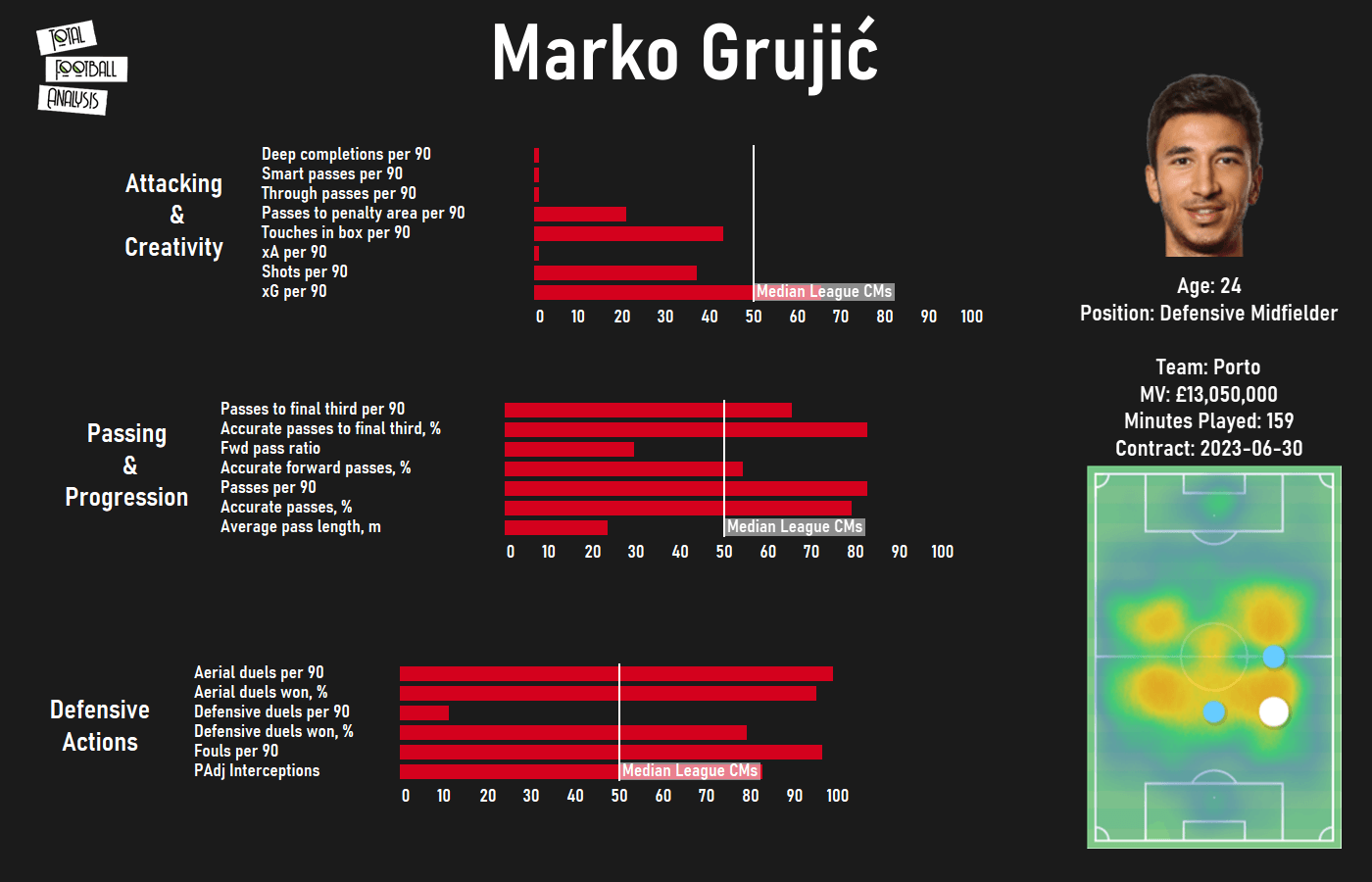
Marko Grujic signed for Liverpool aged just 19 for seven million euros but has only managed to play 16 games for the first team. He’s been more successful in his loans to Red Star Belgrade, Cardiff and Hertha Berlin. In his last two seasons at the German club his performances have been very good (54 games, nine goals and three assists), so Portuguese giants Benfica have taken him on loan for the 2020/21 season. So far he’s struggling to play consistently, getting a total 592 minutes in 12 matches.
Grujic hasn’t played a lot of league minutes so far this season (139 in four matches), so his statistics aren’t as significative and the data analysis will be more superficial. We will still comment on his highlights, but a bigger sample is needed to make any judgement.
He has been playing on both sides of a double pivot, helping the buildup and progressing from deep positions. In the 159 minutes he has played so far in the Liga NOS, Grujic has been very involved in the buildup and has helped to move the ball around very effectively. He’s keeping it safe and prioritizing a high passing accuracy over progressing, but he makes good decisions and when he plays forward he maintains a high accuracy.
On the defensive side, he’s using his height and physicality to win lots of duels both on the ground and in the air. He has a good work rate and tactical intelligence, which explains his high number of interceptions.
It’s difficult to assess Grujic’s performances in the league, but he has shown promising signals and also good performances in other competitions we aren’t taking into account here, so there are still options for him to return to Liverpool and make an impact if he gets consistent playing time.
Kamil Grabara
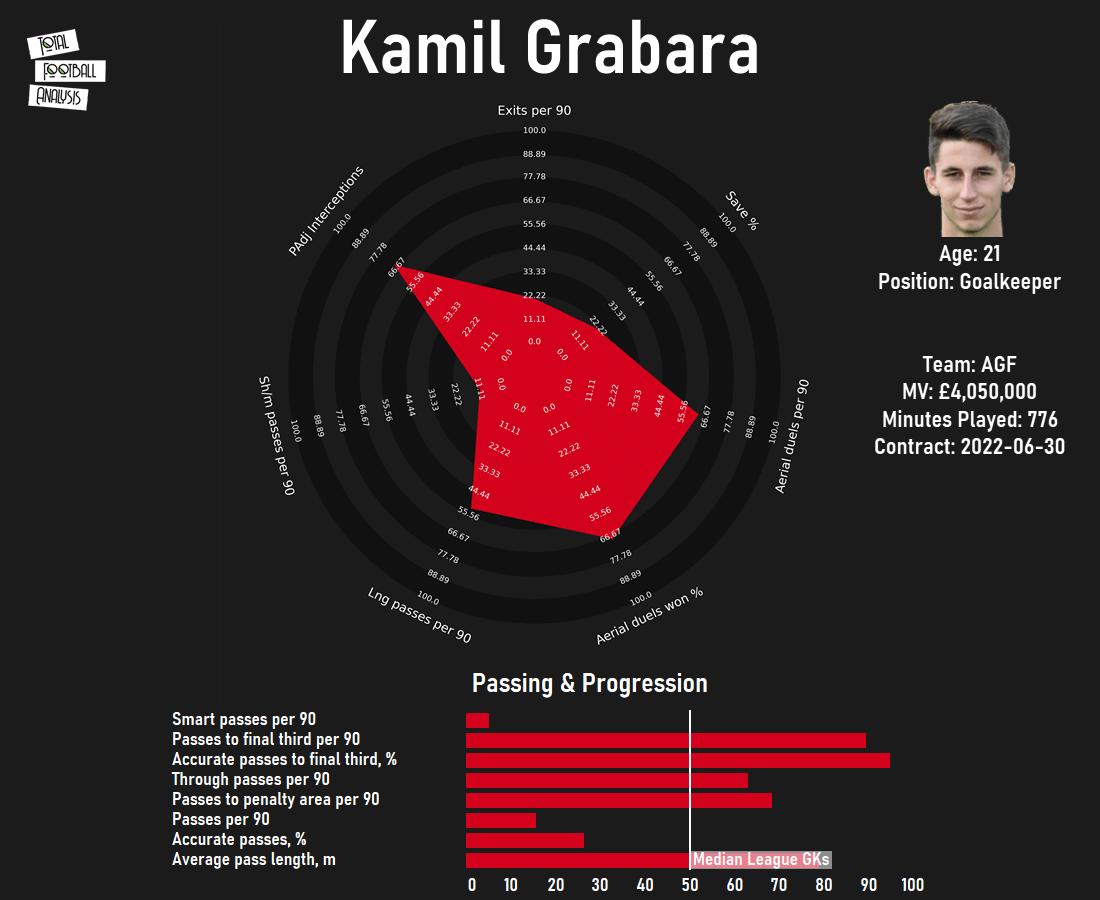
Kamil Grabara signed for Liverpool when he was just 17 and played for their youth sides until he left on loan to Aarhus in the first half of 2019 (18 matches). Last season he was the starting goalkeeper for Huddersfield in the Championship until an injury (28 matches) and this season he has returned to Aarhus and has played every league game so far.
Goalkeepers are difficult to evaluate just from data, but we still get a good first impression about a player’s performance using them. Grabara has been a regular starter so far this season with some highs and lows as it would be expected in a goalkeeper his age.
Grabara has shown he’s a modern goalkeeper with ability to sweep and cover the back of the defensive line, averaging 2.7 possession-adjusted interceptions per 90 (top 31.6%) and getting involved in lots of aerial duels with a good success rate thanks to his 195 cm / 6’5’’.
He’s also very good with his feet, putting a lot of passes in the final third (5.1 per 90 – top 10.6%) with excellent accuracy (72.73% – top 5.3%). His tendency to play long passes means his overall accuracy is quite low, but this is very dependant on his team’s playing style.
On the bad side, Grabara saving percentage is low (61.54% – bottom 21%) but not really worrying. He’s also conceding more goals (1.16 per 90) than he’s expected to (1.11 per 90), which is something that can happen in a relatively small sample but still something he needs to improve.
With Adrián struggling as Liverpool’s second-choice goalkeeper, Grabara needs to get as much experience as he can and show good performances to get a chance at his parent team. His season so far is just ok but he has plenty of time to improve and fight for a position in next season’s squad. Being a homegrown player will play in his favour too.
Ben Woodburn
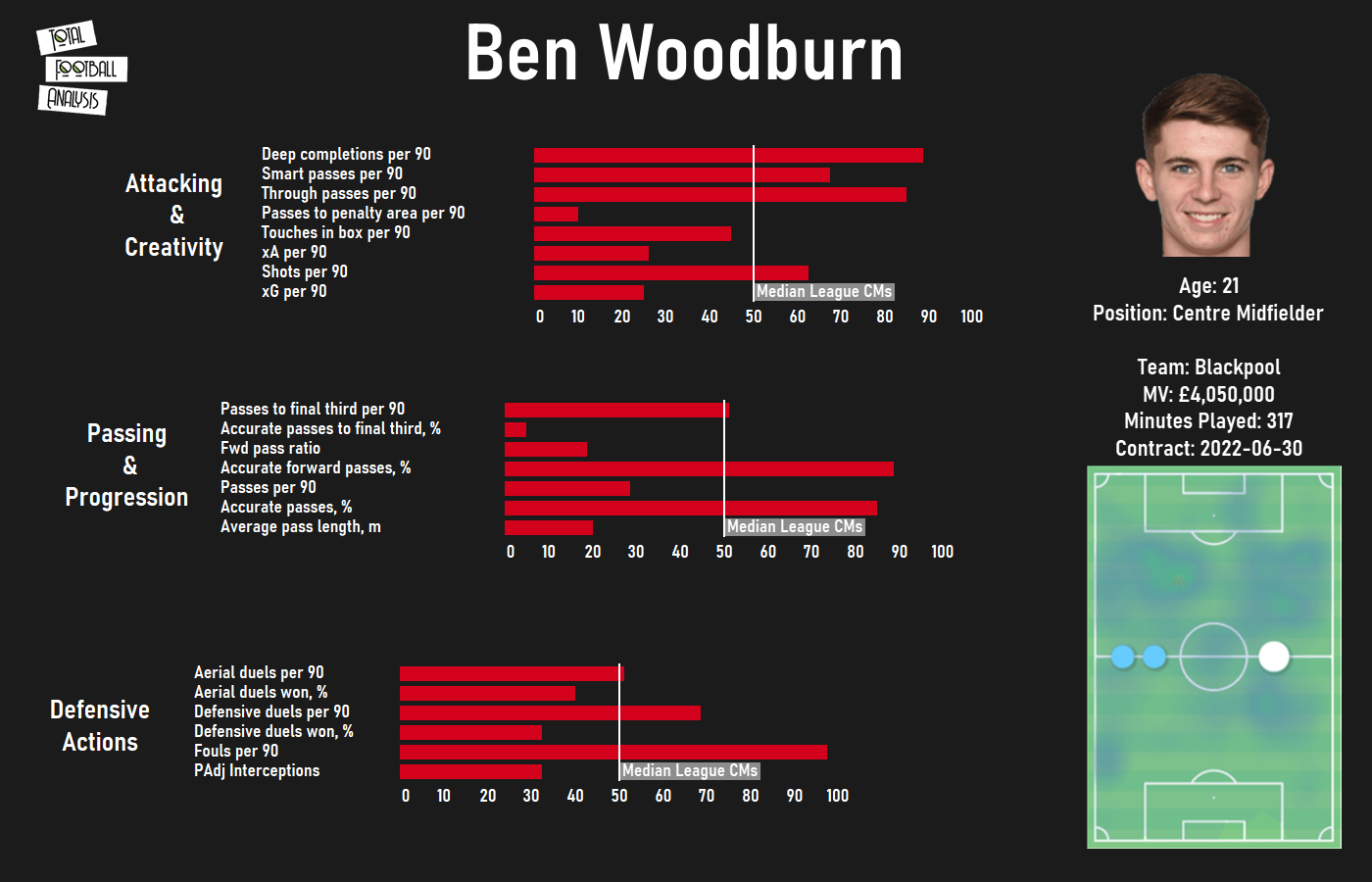
Another academy product and Welsh international, Ben Woodburn has been at Liverpool since he was eight. He played 11 games with the first team before being loaned to Sheffield United for the 2018/19 season. He didn’t enjoy many chances in the Championship (154 minutes in seven games) and his loan was cut short in January. Last season he tried his luck at Oxford United in the League One, but after promising start of the season (11 games, one goal and four assists), an injury kept him out of the team for the rest of the season. This season he’s in the League One again, this time with Blackpool, but again he’s struggling to get regular playing time.
Same as Grujic, Woodburn hasn’t played a lot for Blackpool so far, so his statistics are more extreme than they should. We’ll still assess his season so far but we need to have this in mind and watch his development later on to make a proper judgement.
Woodburn has been played as a central midfielder with lots of freedom to move around the final third. He’s been struggling to get involved in the game but when he does he shows a very good passing ability, with a high accuracy even when playing forward. Despite not getting the ball a lot, he still manages to play very dangerous passes and is one of the best midfielders when it comes to through passes and deep completions. He also tries his luck from distance often, which explains the high number of shots but low xG.
In defence, Woodburn works hard, gets involved in lots of defensive duels and a decent number of aerials, and despite not being physical enough to win them, he helps his team enough.
After a bad injury last season, Woodburn has been given another chance in the League One but still hasn’t shown his quality at the same level as he did for Liverpool U23, where he had 13 goals and 11 assists from midfield in just 34 appearances. This is his last season as an under-21 player and he needs to impress to gain an opportunity at a higher level. Liverpool seems complicated at the moment, but they could opt for another loan instead of cashing in on him if he performs well.
Harvey Elliot
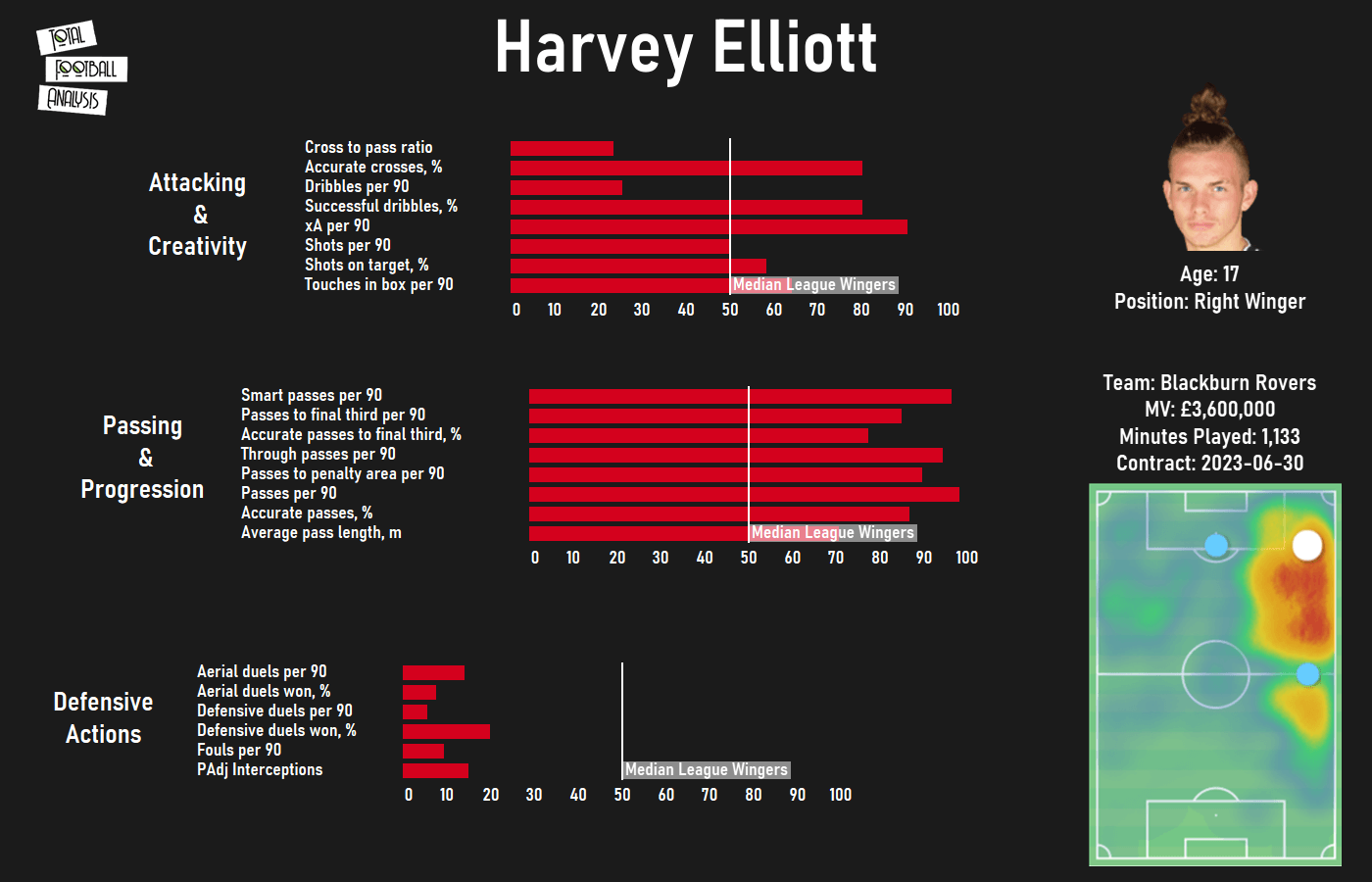
Nowadays, Harvey Elliot is one of the most promising English players. The London-born forward was signed by Liverpool from Fulham in 2019 after becoming the youngest ever Premier League player. The 2003-born winger impressed with the U23s last season and had some chances with the first team in the cups before being loaned to Blackburn Rovers in the Championship this season. His performances have been excellent so far with four goals and four assists in 13 games.
Elliot has been the best performer among Liverpool’s loanees this season. Despite his tender age, he’s enjoying a lot of playing time at Blackburn and is rewarding the team with excellent performances. Playing mostly from the right-wing, Elliot has the ability to appear anywhere in the second line and create danger from wide or central positions.
Even if playing from the wing, Elliot always has the goal in mind, with some good runs into the box. His 1.35 shots per 90 are just ok (top 50%) and he takes those shots from difficult positions (0.1 xG per 90 – bottom 35.8%), but he’s an excellent finisher with 35.29% of his shots being on target (top 41.6%) and a spectacular overperforming of his xG with 0.24 non-penalty goals per 90 (top 19.9%). These figures could revert to average, but an exceptional talent like Elliot can overperform consistently his xG.
He also has great dribbling skills. He doesn’t dribble a lot but when he does he usually beats his man and creates chances (61.9% successful dribbles – top 19.9%). His pace and acceleration are good, but it’s in tight spaces where Elliot is almost unstoppable.
When it comes to creating for others, Elliot again is a differential player. Elliot’s vision and passing range, especially when he receives the ball in the right half-space, is one of the best in the Championship and he also adds the quality to hide his passes and a very direct style, turning into a creative force and acting more as a number 10 than as a classical winger.
He ranks in the top 25% in every passing stat we have considered, getting involved a lot in the attacks and creating danger very often with lots passes reaching the final third (4.45 per 90 – top15.1%) or the box (4.61 per 90 – top 10.4%). His crossing is also way above-average (37.14% success rate – top 19.9%). All these facts explain his excellent expected assists figures (0.24 per 90 – top 9.5%) which his teammates have translated into four assists (0.32 per 90 – top 5.7%). He’s also great at progressing when he receives in deeper positions with 7.07 progressive passes and 3.57 progressive runs per 90 (top 15.1% and 5.7% respectively).
However, Elliot’s defensive work is quite poor and doesn’t stand out in any of the considered metrics. It’s normal for a 17-year-old kid to struggle in defence and this will surely improve as the season progresses, but it’s a very important aspect for Liverpool’s tactics and they will surely insist on this.
Elliot’s season has been excellent so far. Not often you see a kid dominating the men’s game with his intelligence, effectivity and good decision-making. If he can continue his form and focus on producing for his team as he has done so far, Liverpool will be very tempted to keep him in the first-team squad next season even if he’ll be only 18. A talent like his develops better at higher levels and Elliot is surely ready to make an impact in the Premier League.
Taiwo Awoniyi
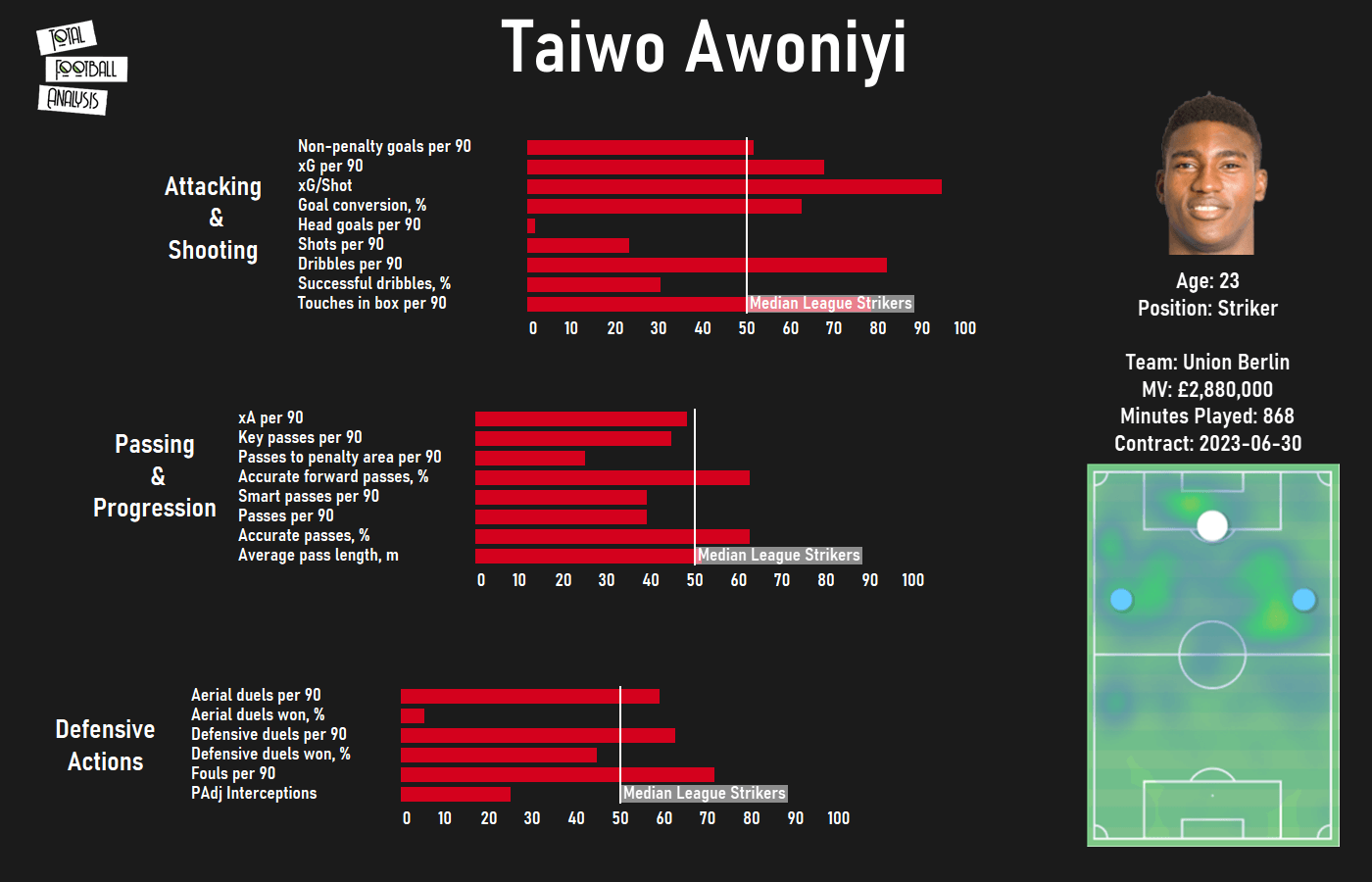
Taiwo Awoniyo was signed by Liverpool directly from the Imperial Academy in Nigeria aged just 18 and has been loaned six times since then without playing any game in a red shirt. After being at FSV Frankfurt, NEC Nijmegen, Mouscron twice, Gent and Mainz, Awoniyi has arrived at Union Berlin in the 1.Bundesliga this season.
Awoniyi is enjoying a good start of the season and has become a regular starter for Union Berlin. He has been moving around the three attacking positions as his pace allows him to create danger from either wing or through the centre of the pitch.
Playing for a non-dominant team like Union Berlin means Awoniyi doesn’t get involved a lot in the game (just 18.15 passes per 90 – bottom 39.2%) and doesn’t enjoy many chances (1.56 shots per 90 – bottom 23.2%), but he’s getting into very good positions and the few shots he takes are very dangerous (0.27 xG/shot or 0.41 xG per 90 – top 5.4% and 22.2% respectively). However, his finishing hasn’t been the best, missing some very clear chances and underperforming his xG, scoring three goals or 0.31 non-penalty goals per 90.
Awoniyi doesn’t have the quality to create for others and ranks in the bottom 35-50% in most passing and creative metrics. He does stand out in creating chances for himself not only by being well-positioned (4.35 touches in the box per 90 – top 21.5%) but also attempting lots of dribbles (4.04 per 90 – top 26.8%) looking to take advantage of his physical power. However, he’s not very skilled and his dribble completion rate is poor (43.59% – bottom 30.3%).
In defence, Awoniyi does his job and gets involved in many duels even if he doesn’t win too many.
Aged 23, Awoniyi is entering his peak and is no longer a young prospect. He will still develop and even if he’s enjoying a good season at a small club in the Bundesliga, it seems very unlikely that Liverpool could recall him in the future. Only if his end product improves and he focuses on his strengths, which means playing simple and using his power to get into good scoring positions, he could become an alternative in attack for the Reds.
Sheyi Ojo
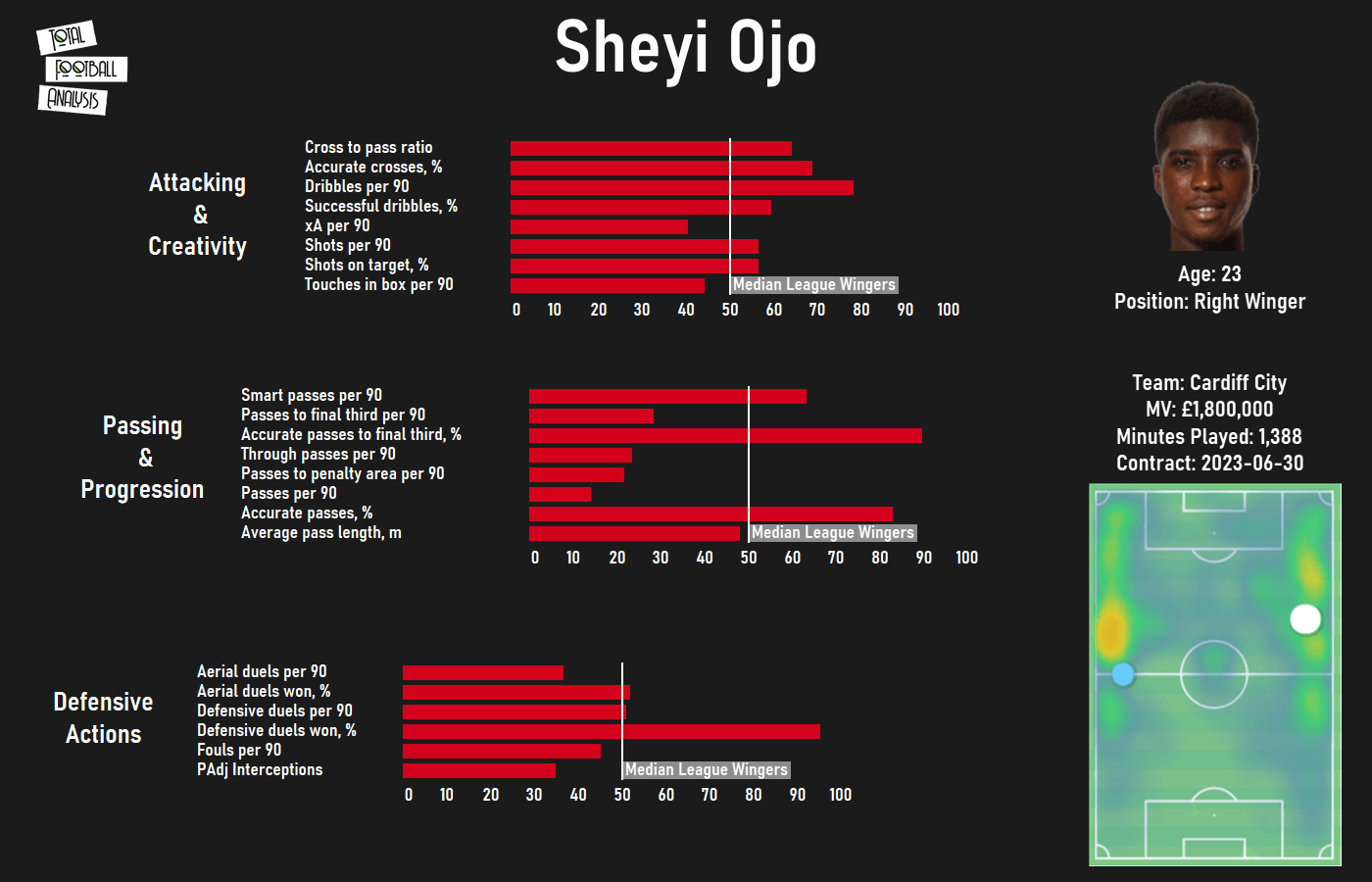
Sheyi Ojo is still the most expensive 14-year-old player ever after his move from MK Dons to Liverpool for 2.5 million euros in 2014, but hasn’t lived up to the expectations. Aged just 23, Ojo is on his sixth loan in the last five years and has only played eight Premier League matches with Liverpool. He’s been loaned to Wigan, Wolves, Fulham, Stade Reims and Rangers before joining Cardiff City last summer. For Cardiff, Ojo has been deployed on both wings and has played over 80% of the minutes so far thanks to his good performances.
Ojo is a very direct winger. His dribbling data is good, attempting 6.61 dribbles per 90 (top 40.6%) and completing 57.84% of them (top 43.4%). He’s not really involved in the build-up and when he receives he usually tries to dribble and cross or shoot. He places his crosses well (34.21% accuracy – top 31.2%) and also takes a good number of shots with 1.49 per 90 (top 43.4%). Those shots are also from good positions, amounting to 0.19 xG per 90 (top 24.6%) and his finishing is ok having scored 3 goals from 2.91 xG so far.
On the creative side and apart from his crossing, Ojo doesn’t have the quality or vision to create or assist. He usually plays simple short passes and prefers to move the ball quickly until he has the chance to dribble, cross or shoot.
In defence, Ojo works very hard and gets involved in more defensive duels than the majority of wingers (5.64 per 90). But what’s more interesting about him is that he wins most of those duels (65.52% – top 4.8%). This could suggest he can be successfully converted into a wing-back, which could be interesting in an attacking side like Liverpool.
Ojo is obviously a good player but not good enough to be a winger at Liverpool. However, his defensive ability could make him a potential backup wing-back on both sides. With Trent Alexander-Arnold and Andy Robertson as the undisputed starting wing-backs, having a homegrown as a backup could save Liverpool money and a spot in the squad.
Adam Lewis
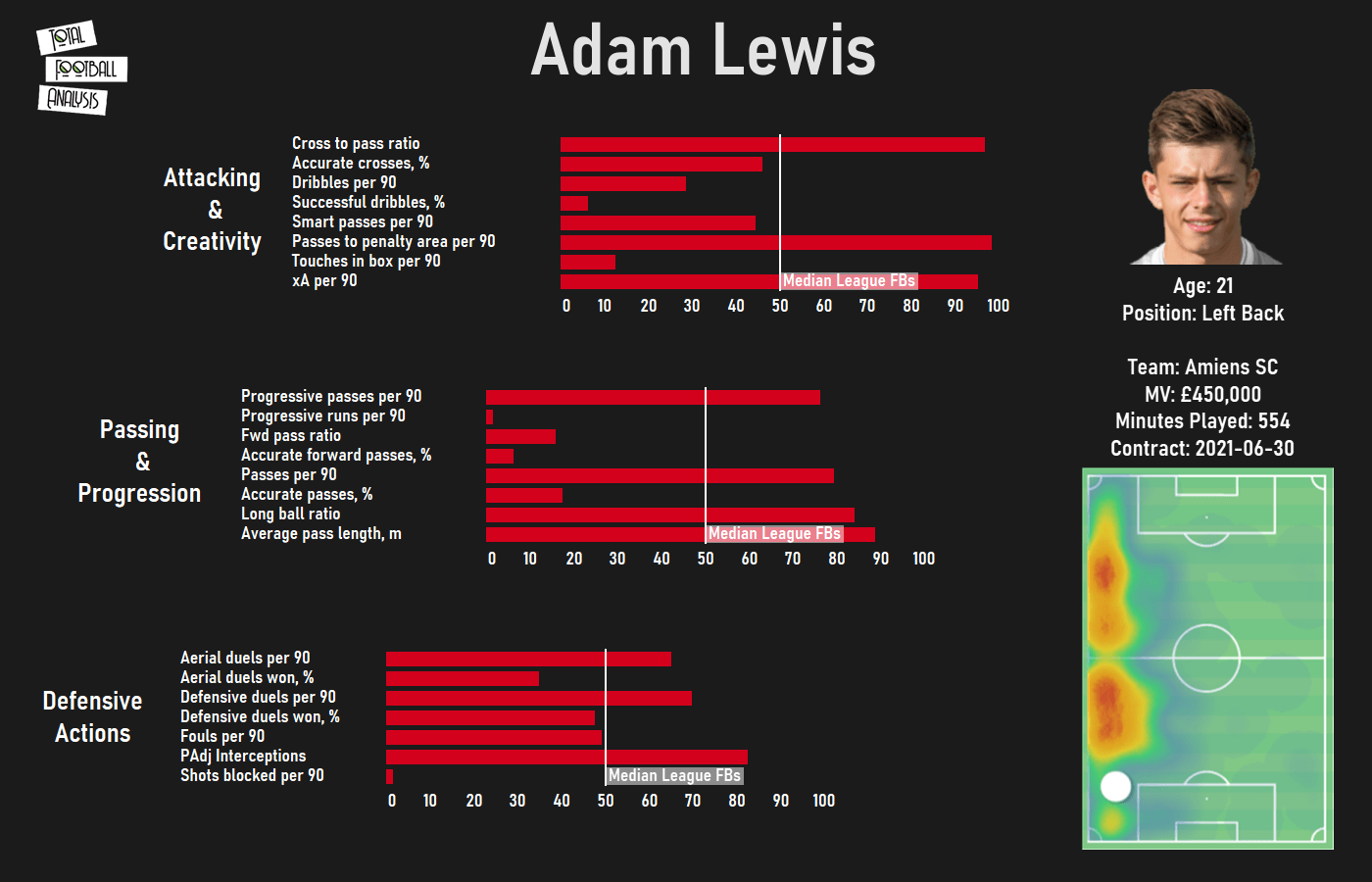
Despite being at Liverpool since he was seven, Lewis isn’t a very known name as he has only played one match for the first team. This 21-year-old left-back has been one of the standout players in the Liverpool academy for years, but this is his first loan and his first chance of enjoying regular first-team minutes. His impact for Amiens after their relegation from the Ligue 1 has been big and he has adapted well to senior football.
Formerly a central midfielder, Lewis isn’t the type of full-back that tends to dribble and take on players, preferring to stay in the middle third acting as a wide playmaker and using his great passing and delivery to progress and create from there. Lewis attempts 1.62 dribbles per 90 (bottom 28.5%) completing just 30% of them (bottom 6.3%) and he’s not better at carrying the ball longer distances either (0.32 progressive runs per 90 – bottom 1.5%).
Playing for a dominant side like Amiens, Lewis gets involved a lot in the attacks, playing 43.7 passes per 90 (top 20.7%). His passing accuracy is low because he often tries progressive passes (10.23 per 90 – top 23.9%) and long passes (7.31 per 90 – top 12.7%). He tends to cross from deep positions, so he does it very often (5.69 crosses per 90 – top 1.6%) with a decent success rate of 31.34% (bottom 46%). This combined with his ability to make passes into the box (6.34 per 90 – top 1.6%) make him one of the most creative full-backs in the league with 0.14 expected assists per 90 (top 4.8%).
In defence, Lewis gets involved in a fair number of duels considering his team is very dominating and excels at intercepting the ball with 8.14 possession-adjusted interceptions per 90 (top 17.5%).
In his first professional experience, Lewis is impressing in a physical and demanding league like the French Ligue 2. He may still be raw and adapting to senior football, but there are some traits in him – primarily his delivery and ability to act as a wide playmaker – that can remind to another Liverpool-born full-back: Alexander-Arnold. Again like Ojo, Lewis could become an interesting squad option for Liverpool, saving money and spots in the squad for differential players and adding to the homegrown quota.
Tony Gallacher
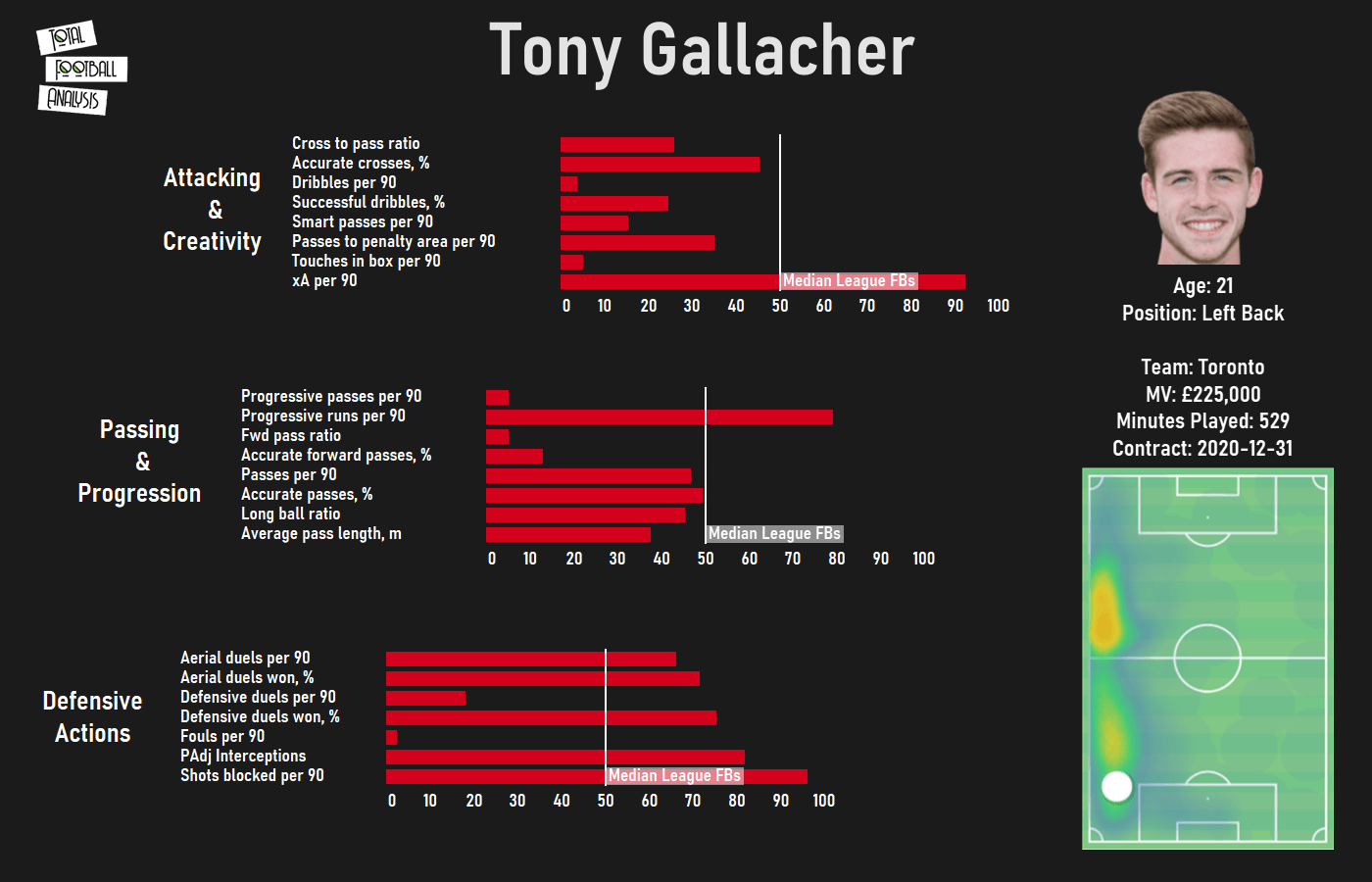
Tony Gallacher is probably the least-known of the players we are looking at in this data analysis. The Scottish left-back signed for Liverpool from Falkirk in 2018 after impressing in the Scottish Premiership with six assists in 26 matches being a teenager but has failed to impress at Liverpool and has played on loan for Toronto in the last months of the MLS.
Gallacher is a hard-working aggressive left-back who’s excellent at defending. Despite being short (173 cm / 5’8’’) he gets involved in 2.89 aerial duels per 90 and wins 58.82% (top 33.8% and 28.6% respectively). He’s also a good defender on the ground and despite not getting involved in a lot of defensive duels he has a high success rate of 65.79% in them (top 24.7%). His positioning is also excellent both to intercept passes (7.95 possession-adjusted interceptions per 90 – top 18.2%) and to make last-minute tackles and block shots (0.68 shots blocked per 90 – top 3.9%).
However, in the attacking phase, Gallacher doesn’t offer too much. He’s energetic and can carry the ball long distances in transitions, which makes him a good progressive runner with 2.04 progressive runs per 90 (top 20.8%). Even if his delivery is not excellent and he doesn’t have lots of quality in the final third, Gallacher manages to mix well his crosses and passes into the box and hits good targets, amounting to 0.16 expected assists per 90 (top 7.8%).
At his age and playing in a minor league like the MLS, Gallacher doesn’t seem to be an option for the future for Liverpool. Despite spending just three months in the MLS, he seems to have found a level in which he can perform and develop, but he’s not expected to be a Premier League player anymore and he should focus on his strengths to reach his full potential.
Other loaned players
We haven’t analyzed the following players:
- Anderson Arroyo – loaned to Salamanca CF in the Spanish third tier, this 21-year-old Ecuatorian left-back has played less than a third of the minutes so far and is very unlikely to get a work permit in the future so it wasn’t worth analyzing.
- Morgan Boyes – this 19-year-old centre-back is on loan at Fleetwood Town in the League One but has only played two matches so the sample wasn’t good enough and the level too low to make any judgements. If he gets playing time he’ll be worth following.
- Loris Karius – loaned to Union Berlin with Awoniyi, the 27-year-old goalkeeper hasn’t featured so far for the German team. The memories from the UEFA Europa League final against Real Madrid are probably enough reason to rule out any possibilities of the German goalkeeper coming back to his parent club.
Conclusion
Liverpool are a smart club that knows how to spend their money and when to save. They have some very interesting players on loan that can fulfil different roles in the squad in the future and save them money to invest where needed.
The likes of Elliot, Wilson, Grujic and Grabara could have been in the current season’s squad but they will surely develop and increase their value while on loan. It will be Liverpool’s decision whether to cash in or use them, but they’ll win both ways.
Others like Lewis are still developing and will probably need another loan before returning to Liverpool. In the case of Awoniyi, Ojo or Gallacher, the most probable is that they are sold unless they dramatically improve their performances or adapt to new positions.
All player profiles in this piece were created by the wonderful Sathish Prasad (@SathishPrasadVT on Twitter). Go check out his stuff!





Comments